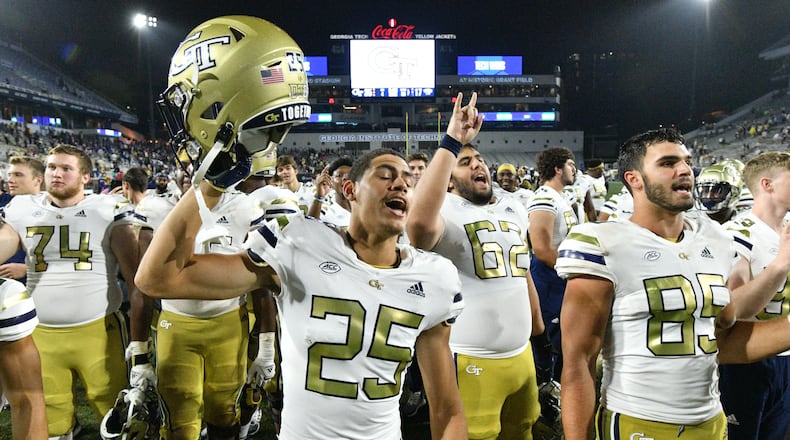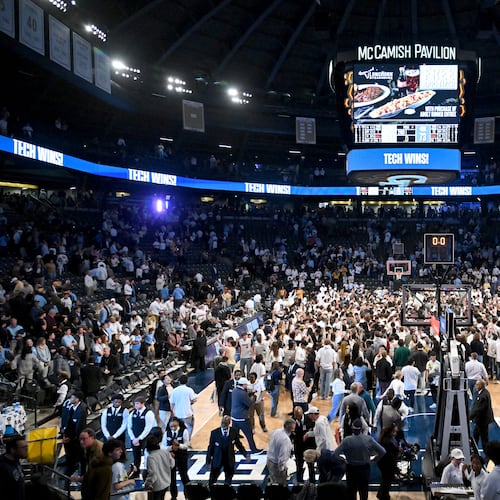On a misty evening at Bobby Dodd Stadium, Georgia Tech took care of business after a slow start. Playing their second game in six days, the Yellow Jackets secured a 35-17 win over Western Carolina on Saturday, improving Tech’s all-time record against current Southern Conference schools to 72-4-4.
Tech is now 1-1 ahead of its Saturday home game with No. 20 Ole Miss in the Jackets’ first regular-season meeting with the Rebels since 1946.
Efficient day for offense
The run game carried the day for the offense as the Jackets had a 34/17 run/pass ratio (it was 30/36 against Clemson) and produced 243 of Tech’s 343 yards. Offensive coordinator Chip Long split carries among running backs Dontae Smith (11 for a career-high 102 yards, including three for touchdowns), Dylan McDuffie (eight for 25 and a touchdown) and Hassan Hall (five for 21).
“I think the biggest thing is we wanted to establish the run,” coach Geoff Collins said. “That was a big point of emphasis all week and take our shots (with the pass) when we needed to.”
Quarterback Jeff Sims contributed on the ground, particularly on a well-designed keeper for 21 yards that preceded Tech’s first touchdown of the game. The offense averaged 6.7 yards per play, scoring its 35 points on 51 plays, remarkable efficiency.
“I thought Jeff did a good job of getting us into the right looks for us to have success in the run game, as well,” Collins said.
As Tech was given partial credit for its moderate successes against Clemson’s vaunted defense, it should be noted that Western Carolina was last in FCS last season in rushing defense (259.5 yards per game) and fourth from last in scoring defense (41.3 points per game).
Sims completed 8 of 17 passes for 100 yards with one interception. As has been his pattern, he mixed in pinpoint deliveries, such as a 19-yard strike down the seam to tight end Luke Benson on a first-quarter third-and-10, with some mistakes. The most notable was his interception on a deep ball to Kalani Norris in the third quarter on an aggressive play call immediately after a Western Carolina turnover.
“Obviously, I wish we could have that one back,” Collins said. “The kid (cornerback Rod Gattison) made a heck of a play.”
Defense rallies from slow start
The Jackets were overwhelmed on the Catamounts’ first two drives, giving up four plays of 20 yards or more and a 13.5 yards-per-play average as they took leads of 7-0 and 14-7. Breakdowns in coverage, which coaches had sought to address over the offseason, were rampant. Defensive coordinator Andrew Thacker was animated on the sideline addressing players after the scores. It’s conceivable that taking the field five days after facing Clemson may have been a factor. The Tigers themselves had some defensive issues early in their win over Furman on Saturday.
“He was just telling us to continue staying together, next-play mentality, do your job, pretty much,” cornerback Myles Sims said.
For the remaining 11 drives, Western Carolina scored three points and averaged 3.6 yards per play. Three drives were ended by Tech interceptions, a fourth on a fumble recovery and another on downs.
That Western Carolina turned the ball over was nothing new; the Catamounts gave the ball away 32 times in 11 games last season, second most in FCS. That Tech was seizing chances, in this case creating takeaways off three ill-advised throws and a mishandled shotgun snap, was a step forward. The Jackets created 13 takeaways last season, tied for 104th in FBS. Their three interceptions matched their season total from last year, which was tied for second fewest in the country.
“It’s a blessing when those opportunities come to you,” said Sims, whose second-quarter interception was the first of his career. “You have to maximize on those opportunities. Our goal is to be the best defensive back corps in the entire league this year. So we take it play by play, game by game, and when the ball comes to you, you have to maximize those. You have to get the ball.”
Stars of the game
Two players who stood out were Smith on offense and linebacker Charlie Thomas on defense. As he has whenever given the chance, Smith produced with the ball in his hands. He has speed to make big plays, like his well-blocked 51-yard touchdown run up the middle, but also the elusiveness and strength to make defenders miss.
Wide receiver Nate McCollum’s 40-yard touchdown run in the second quarter – which gave the Jackets the lead for good at 21-14 – was set up by Smith converting a third-and-1. On the play, he took the handoff and, rather than charge into a line with no immediate hole, deftly changed direction in the backfield twice to avoid a tackle and find a gap, accelerating through the line for a 10-yard gain.
It kept the drive going, allowing Long the opportunity to dial up McCollum’s reverse.
“I’m proud of those boys up front,” Smith said. “They did what they needed to do in order for us to win.”
Thomas waited for two quarters for his opportunity, serving a one-half suspension for his targeting penalty against Clemson. Western Carolina’s early success could be partly attributed to Thomas’ absence, as the Catamounts exploited the inexperience of Thomas’ replacement (Trenilyas Tatum) on back-to-back plays that generated 52 yards and their second touchdown.
Thomas was a playmaking force in the second half with eight tackles, including two for loss (one sack) and an interception. The eight Western Carolina plays that Thomas ended with a tackle gained a total of 30 yards, as Thomas made his plays near the line of scrimmage.
Even in limited playing time, Thomas has started the season well, as he did last year before injuries slowed him down.
“I’ve been playing so many positions; this is the first year I really feel comfortable playing linebacker,” Thomas said. “I played all offseason (at linebacker). Just the cohesiveness of the unit, we just play for each other. I feel like I just want to play for my brothers, to be honest.”
Missed opportunities
Against an overmatched opponent, missed opportunities didn’t cost the Jackets on Saturday, but they can’t afford such largesse going forward. Thanks to three turnovers and a 29-yard punt return by McCollum, Tech had four possessions start inside Western Carolina territory. The four drives produced a punt, a touchdown, an interception and a missed field goal.
“We left some points on the board,” Collins said.
On defense, the Jackets’ pass rush often disrupted Western Carolina quarterback Carlos Davis’ pocket, but he was frequently able to evade tacklers to run for positive yards.
“I knew on tape that he was a really good player, and then you see him in person,” Collins said. “He was impressive in the pocket, escaping the pocket, keeping his eye downfield.”
Against Western Carolina, Tech could withstand not making good on excellent field position and allowing the opposing offense to escape trouble. The Jackets likely won’t have such luxury against Ole Miss, which put up 59 points Saturday against Central Arkansas, and future opponents.
Tech did address its penalty habit from the Clemson game, but Collins seemed well aware that the Jackets can’t count on it being solved permanently.
“We’ve got to continue to work on it every single day and work on our issues and just continue to get better, because I think we all know the quality of the opponents we have coming up, especially the one that is next Saturday at 3:30,” he said.
A familiar formation
Long uncovered an eyebrow-raising portion of the playbook in the third quarter. Tech used a three-back alignment for one drive, lining up in the double-slot formation that former coach Paul Johnson used to great effect over his 11-season tenure. Smith even ran the pre-snap “orbit motion” track that was a staple of the offense.
“It was kind of familiar,” Smith said. “What did they used to call it – A-back? Being an A-back and running the loop, it was familiar. It was something that I did my freshman year a lot in practice and stuff. But we have a deep, deep playbook, and you never know what you’re going to get.”
In the drive, the Jackets ran on all eight plays, moving the ball 61 yards into the end zone.
Its effectiveness may bring it back in future games, or it could be that it was something meant for Ole Miss (and later opponents) to see and have to spend game-planning and practice time on.
About the Author
Keep Reading
The Latest
Featured



